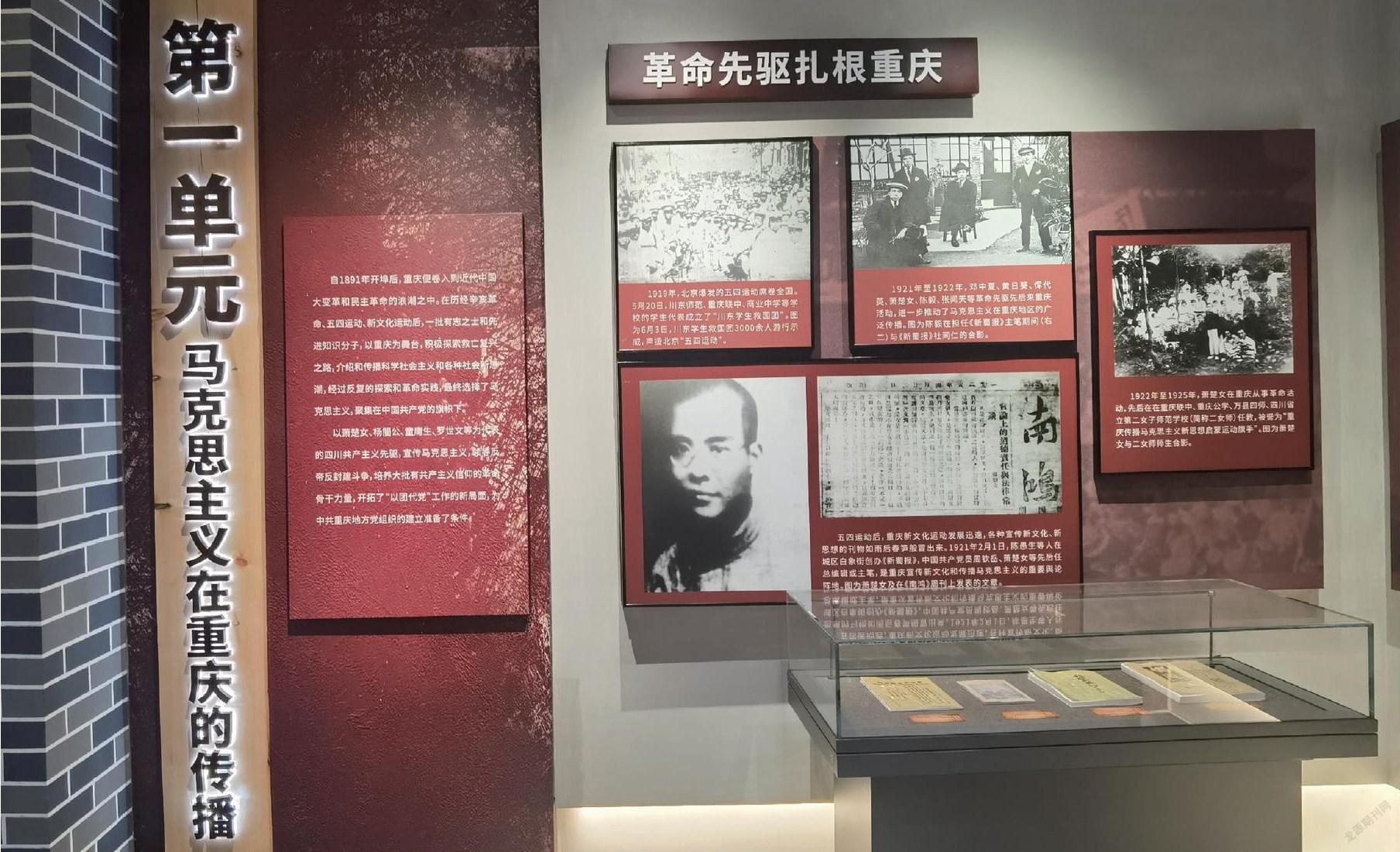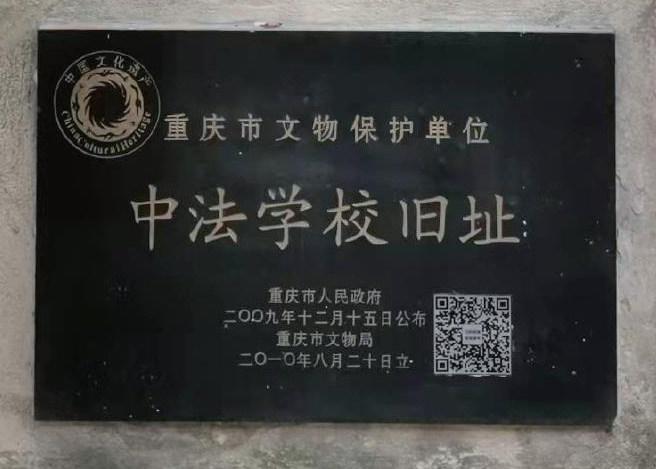重庆最早的中共党组织诞生地“中法学校”



The former site of Sino-French School The birthplace of the earliest CPC organization in Chongqing
在重慶渝中区大溪沟街道人和街社区蒲草田,保留着的一栋中西式砖木结构的二层小楼—中法学校旧址。硬山屋顶、灰瓦黄墙,在周围一片高楼的映衬下,显得格外低调。小楼旁的院墙上,一块块文化展板书写着这栋小楼辉煌的过去。
这栋存世百年的小楼,是中国共产党在重庆的第一所干部培训学校,一大批优秀的共产党员从这里走出去:吴玉章、杨闇公、冉钧、周贡植、任白戈、范长江……
尽管这所学校当时只存在了短短一年半时间,但和这所学校有关的党史名人却影响深远。重庆最早的中共党组织—中共重庆支部就诞生在这里,是中国共产党在重庆的发源地,中法学校也因此具有重要的历史地位和价值。
据渝中区文管所资料显示,中法学校旧址原名懋园。1925年8月,吴玉章受中共中央派遣回四川工作,为了更有效培养革命干部,决定在重庆筹建一所干部培训学校—中法学校。他的想法得到了杨闇公和冉钧的一致赞同。后来,他们租下大溪沟谭家花园和懋园的一部分作为校本部,又在附近居民楼租了一些房子作为宿舍。因该校有大学部,故又称为“中法大学”。
1925年9月4日,中法学校正式开学,吴玉章任校长,聘请了杨洵、冉钧、周贡植、李嘉仲、肖清华、童庸生等中共党员和留学归国的经济学家漆南薰任教师。学校吸纳了一大批进步青年,最初有学生200余人,到1926年春季增加到400人,1927年开学时已达1000余人。学校以“造就革命的、为共产主义社会奋斗的人才”为目的,宣传马克思主义思想,激发学生的反帝反封建爱国热情,呈现出生机勃勃的革命景象。中法学校由此站在时代的前列,成为重庆学生运动的中坚力量和四川革命斗争的重要阵地。
1926年1月,冉钧、周贡植、缪云淑在中法学校成立重庆最早的中共党组织—中共重庆支部。同年2月下旬,在此成立首个中共重庆地委—中国共产党重庆地方执行委员会,杨闇公当选为第一任书记。
1927年重庆“三·三一”惨案后不久,中法学校被反动势力捣毁被迫停办,杨闇公英勇就义。但中法学校的学生却如星星之火分散全国,为中国和四川的大革命运动培养了一大批骨干力量。
作为重庆市文物保护单位,现存的中法学校的校长楼部分在渝中区特色老社区打造中进行了修缮。2021年4月23日,中法学校旧址布展中共重庆支部史实陈列展正式对外开放。
展览由“马克思主义在重庆的传播”“中法学校的诞生”以及“重庆最早党支部之一成立”三个单元组成。采用“图文+场景复原+多媒体”的形式,在现有的史料基础上,经过严格考证,全面展示重庆中法学校创立、中共重庆支部建立、中共重庆地方执行委员会成立以及领导重庆地区革命斗争的光辉历程,深切缅怀革命先辈,探寻光辉足迹,感悟创业艰辛,继承和发扬革命先驱的光荣传统。
中法学校开启了党在重庆的伟大事业,它所播撒的革命火种不断传播、发展,在推动中国革命和建立新中国的征途中,绽放出了炽热耀眼的光芒。如今,中法学校旧址被越来越多的人所了解,不少单位组织到此参观学习,在史料文字、照片中,踏寻着英雄足迹,传承革命先辈的红色精神。
(部分资料由渝中区大溪沟街道提供)
编辑/贺煜
In Pucaotan, Renhe Street Community, Daxigou street, Yuzhong District, Chongqing stands a small two-storey building with Chinese and Western style in its brick and wood structure - the former site of Sino-France School. The flush gable roofs, grey tiles and yellow walls are particularly understated against the high-rise buildings in the surrounding areas. On the courtyard walls adjacent to the small building, blocks of cultural bulletin boards murmur the glorious past of the small building.
This century-old building is the first cadre training school of the Communist Party of China in Chongqing (CPC). A myriad of outstanding CPC members was cultivated here: Wu Yuzhang, Yang Angong, Ran Jun, Zhou Gongzhi, Ren Baige, Fan Changjiang, ect.
Though the School existed for only a year and a half, many Party history celebrities related to the school exerted a far-reaching impact. CPC Chongqing Branch, the earliest CPC organization in Chongqing, was born here. As the birthplace of the CPC in Chongqing, Sino-French School, therefore, boasts an important historical status and value.
According to Cultural Relics Management Office of Yuzhong District, the former site of Sino-French School was originally named Maoyuan. In August 1925, Wu Yuzhang was sent back to work in Sichuan by the CPC Central Committee. In order to effectively train revolutionary cadres, Wu decided to set up a cadre training school in Chongqing, namely Sino-French School. His idea was unanimously agreed by Yang Angong and Ran Jun. Later, they rented parts of Tan's Garden and Maoyuan in Daxigou as the main campus of the School, and some rooms in nearby residential buildings as dormitories. As the School had a university department, it was also known as "Sino-French University".
On September 4, 1925, the Sino-French School officially opened. Wu Yuzhang served as the president and hired Yang Xun, Ran Jun, Zhou Gongzhi, Li Jiazhong, Xiao Qinghua, Tong Yongsheng and other CPC members, and Qi Nanxun, an economist returning from overseas study, as teachers. The School attracted a large number of progressive youth. At first, there were over 200 students, then the number of students increased to 400 in the spring of 1926, and surged to 1,000-plus in 1927 upon school opening. Aiming at "cultivating revolutionary talent for the Communist society", the School publicized Marxism to stimulate students' patriotic enthusiasm against imperialism and feudalism, presenting a vibrant revolutionary outlook. Thus, Sino-French School stood in the forefront of the times and became the backbone of the student movement in Chongqing and a stronghold in the revolutionary cause of Sichuan.
In January 1926, Ran Jun, Zhou Gongzhi and Miao Yunshu established the earliest CPC organization in Chongqing, namely the CPC Chongqing Branch here. In late February of the same year, the first CPC Chongqing Prefectural Committee - the local executive council of CPC Chongqing Committee was established with Yang Angong elected as the first secretary.
Shortly after the March 31 Massacre in Chongqing in 1927, the Sino-French School was destroyed by the reactionary forces and forced to close. Yang Anong was executed. The students of Sino-French School, scattering across the country, however, turned into the massive backbone force for the great revolutionary movement in China and Sichuan.
As a key cultural relics protection unit in Chongqing, the former site of the Principal Building of the Sino-French School has been renovated in building characteristic old communities in Yuzhong District. On April 23, 2021, the Historical Facts Exhibition of the CPC Chongqing Branch held in Sino-French School was officially opened to the public.
The exhibition consists of three units: "the Spread of Marxism in Chongqing", "the Birth of the Sino-French School" and "The Establishment of One of the Earliest Party Branches in Chongqing". In the form of "photo and text + scene restoration + multimedia", based on the existing historical materials and through strict textual research, the exhibition comprehensively showcases the glorious journey of the establishment of Chongqing Sino-French School, the CPC Chongqing Branch and local executive council of CPC Chongqing Committee and leading the revolutionary struggle in Chongqing, deeply cherishing the memory of revolutionary forefathers, retrieving their footprints and perceiving the hardships of entrepreneurship, inheriting and carrying forward the fine tradition of revolutionary vanguards.
The Sino-French School has opened the great cause of the Party in Chongqing. The revolutionary seeds it planted have been continuously spread and developed, and has bloomed into a fiery and dazzling light on the journey of promoting the Chinese revolution and establishing the New China. Today, more and more people are aware of the former site of the Sino-French School. Many units come here to visit and study in order to follow the trails of heroes and inherit the red spirit of the revolutionary forefathers in historical text and photo materials.
(Partial data are provided by Daxigou Street, Yuzhong District)
Editor/He Yu

